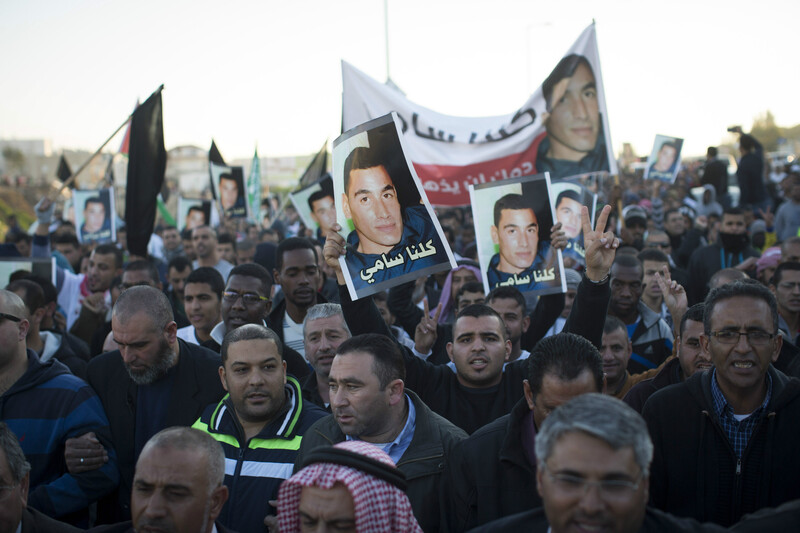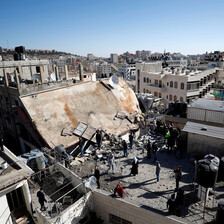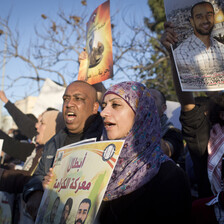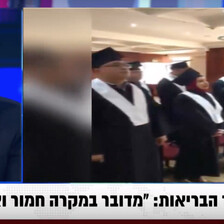The Electronic Intifada Jerusalem 13 February 2015

Palestinian Bedouins take part in a march in the southern town of Rahat to condemn the killing of two residents by Israeli police on 20 January.
ActiveStillsLast month, police killed two unarmed Palestinians in Rahat, the largest Palestinian Bedouin city in the Naqab (Negev) desert in the south of present-day Israel.
Twenty-two-year-old Sami Jaar was killed on 14 January. Four days later, Sami Ziadna died from excessive tear gas inhalation when Israeli police clashed with local youth during Jaar’s funeral procession. The killings sparked a seemingly unprecedented wave of protests in Rahat.
“I am 37 years old and I have never seen this much anger and violence in the city,” said Fadi Mashamra, president of the Regional Council for Unrecognized Villages in the Negev, a local grassroots committee established in 1997.
The protests in Rahat were accompanied by smaller ones in other Palestinian towns in the country, in addition to a call for a general strike on 20 January.
Since that topsy-turvy week in Rahat in mid-January, though, order and normalcy appear to have been restored.
Pattern
The killings of Jaar and Ziadna, and the protests that followed them, echoed what happened in the Galilee village of Kufr Kana following the police killing of Kheir Hamdan in December.
To understand the latest events in Rahat, one cannot view them separately from the wider context of land expropriations, home demolitions and the ongoing persecution of the Naqab’s Palestinians.
The protests were not simply isolated responses to police killings. Rather, they were the result of accumulated grievances.
The protests can be viewed as a follow-on to the campaign during the summer of 2013 to topple the Prawer Plan, an Israeli government program intended to displace tens of thousands of Palestinians in the Naqab. The plan was withdrawn in December that year after sustained protests by Palestinian citizens of Israel.
The mobilization against the Prawer Plan played a key role in radicalizing a significant portion of youth in Rahat and nearby towns.
Concentrated in ghettos
In Rahat, a city planned by the Israeli government, locals suffer from extreme discrimination, terrible infrastructure and high poverty rates matched only by those Bedouin villages which Israel refuses to recognize.
Rahat was established in 1971 as part of Israel’s forced urbanization of the Bedouin community in the Naqab. The Israeli authorities presented the establishment of Rahat as a trailblazer in Israel’s project of “development.” But the real intention behind the move was to concentrate Bedouins in poverty-stricken, overcrowded “cities” and to forcibly change the indigenous residents’ way of life.
Israel has always seen Palestinian-Bedouin residents in the Naqab as a burden to be dislodged — and Rahat and other cities were the initial dumping grounds to get rid of the “Bedouin problem.”
Those cities were established without the slightest respect for the Palestinians’ right to self-determination. Local Palestinians were not consulted about and did not participate in the process of planning their own cities.
Such cities would not just concentrate the native Bedouins in ghettos and lay the groundwork for Judaizing the Naqab. They would be administered by local authorities that collaborated with Israel’s apartheid system in a bid to ensure that the indigenous population remained obedient.
With skyrocketing unemployment, densely-populated slums and no room for expansion, those cities, including Rahat, turned into a fertile ground for crime, drugs and social ills resulting from the lack of proper planning and arbitrary urbanization.
Surprise reaction
Israel also capitalized on the state-engineered poverty faced by Bedouin youth. With few employment opportunities, Bedouin were offered economic incentives to serve in the Israeli military. By making the entire Bedouin community appear pro-Israel to fellow Palestinians, Israel was resorting to the classic “divide and rule” tactics employed by imperial powers.
So it came as a surprise — perhaps even for the Israeli police — to see such a wave of protests organized by the local population of Rahat. Part of the surprise stems from the orientalist view of Bedouins as a passive, patient population that cannot mobilize or that lacks any political or national consciousness.
The Israeli police even spread rumors that Bedouin involved in recent protests were not from Rahat.
“When we were protesting one Israeli police officer came to me and said: ‘I cannot believe that those rioting are Bedouin. Our own Bedouin would never do things like this. You must be wary of the outsider,’” Hind Salman, a political and feminist activist from Rahat, told The Electronic Intifada.
It is this mentality of “our own Bedouin” that many activists in the Naqab are hoping to tackle.
“We are beginning to see a major change in the relation between us and the State of Israel,” Fadi Mashamra said.
“It’s time to move beyond the citizenship discourse. Israel cannot trample upon our dignity and expect us to remain silent and tolerant.”
Clash of mentalities
Much like the Kufr Kana protests — and those against the Prawer Plan — the protests in Rahat illustrated a clash not as much between two generations as between two mentalities.
One group — overwhelmingly led by youth, many of whom had not previously been politically active — were eager to take to the streets. They were angered by a clear attack on Palestinian dignity.
The other group, including local councils, traditional patriarchs and most of the political elite, tried to contain the anger. They used rhetoric about the need to “protect property” and “protest in a civilized fashion.”
This means that forces that ostensibly exist to serve the Palestinian public interest do Israel’s job of housekeeping. In Rahat, this was particularly apparent as calls for youth to go home were repeatedly made through the loudspeakers of mosques across the city.
A week following the killing of Sami Jaar, a member of the so-called Rahat Popular Committee, Ali Dahsan, addressed Rahat’s youth on the Nazareth-based Ashams Radio. “You’ve done your job and shown your anger and made your voice heard,” he said. “Now it’s time to go home and let things go back to normal and let the professional committees do their job of holding police accountable.”
The same patronizing committee struggled to get permission from the Israeli police to hold a sit-in protest in Beir al-Sabe, another city in the Naqab, to demand the release of the detainees arrested during and after the protests. The permit only allowed a limited number of participants.
Another problem encountered by protesters in Rahat was the perceived lack of support from other Palestinian towns in present-day Israel.
Salman believes this had to do with the marginalization of the Naqab by Palestinians themselves and with Israel’s success in dividing Palestinian communities. While the High Follow-Up Committee for Arab Citizens in Israel and other Palestinian groups have spoken about the Naqab being at the heart of the Palestinian struggle, Salman argued that such declarations are “just slogans.”
“We feel that even Palestinian activists from the north look to the Naqab as a remote area, that they live in a bubble,” she added.
An additional obstacle to mass mobilization at the moment is that the political parties representing Palestinian citizens of Israel are preoccupied with the elections to Israel’s parliament, the Knesset, scheduled to take place in March.
Four such parties have formed the United Arab List in order to contest the elections as a joint force.
Was the United Arab List created solely to win seats after the threshold for the percentage of votes needed to secure representation was raised? Or will it also work to achieve grassroots unity in the struggle for Palestinian rights? This remains to be seen.
What is certain, however, is that Palestinian parties must come up with a new strategy if a sustained movement is to be created. Formal unity for the sake of winning parliamentary seats will not suffice.
Budour Youssef Hassan is a Palestinian anarchist and law graduate based in occupied Jerusalem. She can be followed on Twitter: @Budour48.






Comments
Resistance in Rahat
Permalink mike french replied on
Compelling analysis of increasing radicalism of young Bedouin in Rahat; the political elite that attempts to contain their anger 'doing Israel's housekeeping' and the obstacle to mass mobilization represented by overpreoccupation with electoral considerations focussed on the Knesset. Thank you Budour Youssef Hassan.
i agree with the essential
Permalink Xian Li replied on
i agree with the essential content of this article but... since when were Bedouins palestinians? the bedoins of the negev identify far more with the Bedouin of egyptian sinai, not with palestinians in the west bank. this innovation in nomenclature was criticized by many israeli bedouin when it was attempted by israeli palestinian MKs so its incredibly disappointing to see it replicated here. it feels like an (unnecessary and counterproductive) attempt to appropriate the injustice and persecution of another people for the sake of adding rhetorical potency to the palestinian narrative.